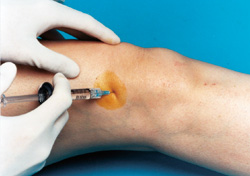Intra articular injection is an injection given in a joint to treat conditions like gout, tendinitis, bursitis, rheumatoid arthritis, carpal tunnel syndrome, psoriatic arthritis and sometimes osteoarthritis. In the procedure, the affected joint is injected with a hypodermic needle, through which anti-inflammatory agents are delivered. This procedure is also used to remove extra fluid from the joint.

What Is Intra Articular Injection?
It is a procedure used to reduce inflammation and pain in joints and it has been used since 1950s. The swelling and pain in the joints are mainly caused by reduced blood flow and an increase in the white blood cell count. In this procedure, there is less risk to the tendons, ligaments and nerves while providing fast and long lasting relief from pain.
Intra articular injection is particularly given to people who have acute or chronic pain in joints, which does not subside with oral medication for pain or inflammation. The joints in which the injection can be given are knees, shoulder, hips, spine, joints of hands and feet and sometimes even between breastbone and ribs.
How Does Intra Articular Injection Work?
The injection usually contains corticosteroids which reduce inflammation. A lot of factors are decreased by these steroids, including macrophages, mast cells, lymphocytes and phagocytosis. It also reduces lysosomal enzyme release and other inflammation mediators like interleukin-1, prostaglandins and leukotrienes so that the pain goes down. Sometimes, these are helpful in non-inflammatory condition like osteoarthritis. It also helps prevent degradation of cartilage.
Hyaluronan can be used with the injection to lubricate the joint and improve the motion range. It is usually done when there is cartilage damage or reduced synovial fluid. Local anesthetics are used sometimes in intra articular injections to provide temporary analgesic effect. However, there are some reports based on animal studies that these injections can cause reduction in chondrocyte density.
How Long Does Intra Articular Injection Remain Effective?
Various types of steroid preparations can be used by doctors when administering intra articular injections. The effectiveness of the injection will depend on the preparation as well as the technique used by the doctor.
- Effectiveness of Steroid Injections
Hydrocortisone is a short-acting and weak injection. The next which works for 1 to 2 weeks is Methylprednisolone. Aristospan which is made from triamcinolone can show effect from a week and last for months. Celestone, made from betamethasone, lasts for 2 to 8 weeks. Preparations like Kenalog and Aristocort, from triamcinolone is effective for 4 to 16 weeks.
- Effectiveness of Hyaluronan Injections
Hyaluronan injection is given to patients who do not get relief from anti-inflammatory medicines or other oral pain meds. It helps in buying time before undergoing a knee replacement surgery. Three to five weeks of session with these injections can give one year of relief to the patient. When the effect starts to wear off, the injection can be repeated.
Benefits of giving a hyaluronan intra articular injection have been seen in 20% of patients. The effect is seen in one to two weeks in the patients who respond well to the treatment. There is no evidence that hyaluronan injections are better than oral naproxen.
Side Effects of Intra Articular Injection
Side effects of intra articular injection can be caused by the medicine which is injected, the tape used in the process or the disinfectant used to clean the area. 1 in 15000 injections of corticosteroids can result in infections or complications, hence is quite rare. 1 in 50 patients can have post injection flare in which the joints have swelling and pain for a long time. It takes a few days for the pain to subside. Frequent corticosteroid injections may cause joint damage.
Note
1. It is not advisable to have multiple injections in the same site or joint. Fat atrophy at the site of injection and a tendon in the path of the injection could get ruptured.
2. In case of any known allergy to the medication, the injection should not be given. It should also be avoided if there is infection in or around the joint.
3. Steroidal injection should be avoided in people suffering from diabetes as it can increase blood glucose. Repeated injections can also cause destruction of the joints. A gap of 3 months is recommended between 2 steroidal injections at one site or joint.
4. Hyaluronan injections have to be given in a 3 to 5 week series.
